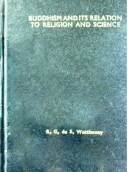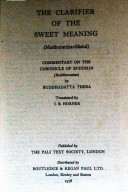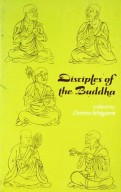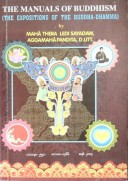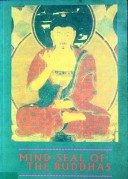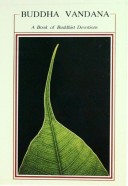Tìm Sách
Sách tiếng Anh-English >> Buddhism & Its Relation To Religion & Science
Thông tin tra cứu
- Tên sách : Buddhism & Its Relation To Religion & Science
- Tác giả : R. G. de. S. Wettimuny
- Dịch giả :
- Ngôn ngữ : Anh
- Số trang : 380
- Nhà xuất bản : M. D. Gunasena &Co. Colombo
- Năm xuất bản : 1961
- Phân loại : Sách tiếng Anh-English
- MCB : 1210000004802
- OPAC :
- Tóm tắt :
FOREWORD
His Excellency Dr. G. P. Malalasekera, D.Liti., M.A., Ph.D. (London).
My first contact with Mr. Wettimuny was about ten years ago when he contributed a series of learned and thought-provoking articles to the official organ of the Colombo Young Men’s Buddhist Association, The Buddhist, of which I was then Editor. Chiefly, I believe, as a result of these articles he came to be in great demand as speaker at meetings and discussions sponsored by organizations both of Buddhists and non-Buddhists. The main theme of his addresses to these groups, which always proved to be stimulating, has been the teachings of the Buddha, particularly their interpretation in the light of modern knowledge.
I am aware that in the interval between my first contact with Mr. Wettimuny and now he has devoted himself assiduously to the study of the topic which he has made his special subject of investigation. It is the result of this deep and prolonged study that he has now presented to us in the present publication. I am very happy that a valuable opportunity has thus been provided for those interested in making a serious and sustained effort for the understanding of the problems involved.
The problems are, indeed, many. Buddhism, by itself, comprises a vast field of doctrine and philosophy, a comprehensive knowledge of which it would be impossible even for a master-mind to achieve in a single lifetime. Our author has, therefore, wisely confined himself to Theravada, the teaching of the Buddha which is known and practised in Ceylon for more than 20 centuries and which rightly claims to be the closest available to the original, or, as it is sometimes picturesquely called, primitive Buddhism. The tremendous advances in Science in modern times make the possession of even a nodding acquaintance with its many ramifications a task of almost insuperable difficulty except, perhaps, for those who have completely dedicated themselves to such an achievement.
The aim which Mr. Wettimuny has set himself, that of discussing Buddhism in relation to Science and not even to Science alone but also to Religion, (thereby greatly widening the scope of discussion) is, thus, a very ambitious one.
It is, to say the least, a most commendable endeavour, especially at a time when there is a great desire among intellectuals in many parts of the world to inquire into and understand the Message of the Buddha. That Message has always laid great emphasis on the importance of following the scientific method in the search for Truth. The Buddha described his teaching as “ehi-passika” the “come-and-see”. Teaching, which invites and deliberately encourages search and investigation, as opposed to blind faith and acceptance of authority.
The most important, in fact the most unique part of the doctrines of Buddhism is that dealing with the mind and its workings, the understanding of which is essential for the development of spiritual insight, ultimately leading to the realization of Truth, the knowledge of things as they really are and not as they seem to be. This knowledge is the basis of real happiness and, according to the Buddha, is indeed synonymous with happiness. The West has so far very largely, almost exclusively, restricted its researches to the exploration of the physical factors of the universe and acquired insight into the physical sciences. It is a consummation devoutly to be desired that the time will soon come when efforts will be made by scientists of the West to investigate with equal energy, persistence and enlightenment the realm of the mind. It is because I feel that this book will help in hastening the dawn of that day that I give it my blessing, and earnestly hope that its success will be such as to encourage Mr. Wettimuny to continue his studies with unabated vigour so that mankind at large may thereby reap a rich harvest of wisdom and understanding.
Colombo, 5th July, 1961.
AUTHOR’S PREFACE
Here, Buddhism is not offered by itself. It is offered together with and in relation to Religion and Science. And what seems most fitting as a preface is an explanation for it.
A few centuries ago, the necessity to lay Buddhism side by side with Science hardly existed. But whilst Religion lingered, Science developed very rapidly; and the accent is on Science. Today a man has been catapulted into space to orbit the earth, and brought back safely home. But along with it there is the talk of a Botulinux Toxin that can wipe out life from the face of the earth in a matter of hours. The material benefits that Science has so amazingly given mankind have caused the intelligent mind to pass hurriedly by anything that cannot be scientifically proved on an experimenting table. What is more, where Science cannot experimentally demonstrate, the tendency is to fall back on the extreme of mere belief. Many minds are content to remain within this framework: to leave everything materialistic and objectively demonstrable to Science, and to leave everything that appears to be beyond being merely materialistic, and objectively indemonstrable, to Religion. There are minds, however, that are satisfied with neither, and are diligently seeking for an explanation that, whilst being fully coherent within itself, is capable of being reached here and now. To such, Buddhism is here offered, and hence the method of presenting it. If this mode of exposition is not adopted all the truly edifying questions will not be met. And I am convinced that, to the inquiring mind of today, it is the most helpful method of presenting Buddhism—a conviction which grew in me in the process of delivering some talks on the subject to University audiences. I repeat, it is only then that one can come across all the worthwhile questions that can be asked. This method was however brought home to me by the works of that outstanding exponent of Buddhism of this century. Dr. Paul Dahlke of Germany. Dahlke’s works are seldom mentioned; perhaps less frequently read. Some even judge they are out of date, because they were written at a time when Science was more or less in its infancy. But this is a hasty judgment; and as all such judgments are, is sadly lacking in depth. With me the case has been different. Over ten years ago the late Venerable Soma Maha Thera introduced to me—a raw seeker with confused mind—Dahlke’s works. Throughout the ensuing years they helped me greatly to clear the thorny weeds which lay upon the path of clear thinking; and for this I am humbly grateful. Dahlke’s works are not out of date because even though the scientific concepts prevalent in his time have to a large extent now been given up, the ideas that he has expressed with regard to the place that Buddhism holds in the mental life of mankind are not out of date. Whatever be the data that Science has collected at any one time, the method of collecting such data, and the manner of interpreting them have remained the same. If Dahlke’s criticisms are out of date, then those of men like Poincare are also out of date. Clear, penetrative thinking is always modern, always useful. But unfortunately it is difficult, and makes heavy demands on one. This heavy demanding is the only “objection” I can see to Dahlke’s works, if one must speak of objections. In this book, I have in more than one place attempted to expand on some of his valuable ideas against the background of current scientific concepts and discoveries as simply as I could. Whilst being indebted on the scientific side chiefly to the works of Poincare, Darwin, Eddington, Jeans, Frank, Nagel. Halliday and Oppenheimer, in the manner of presenting the Buddha-word, I stand here on the shoulders of this profound thinker. On his original, creative, and most stimulating manner of presenting the unique nature of the Buddha-thought against the background of a current era’s thinking, I have built.
Though the title of the book does not suggest it, I have also attempted to show the Teaching of the Buddha in relation to the fundamental tenets of the prominent Western philosophies wherever it has seemed worthy. That the reader has a fair acquaintance with these philosophies has been taken for granted so as to avoid the work becoming too lengthy by expounding them over again. Bearing in mind, however, the reader who may not be having such an acquaintance, I have tried not to involve the knowledge of philosophy as an essential requisite. Knowledge of the various religions and of Science in general is required of the reader if he is to make the most of it. though no knowledge of Buddhism at all is called for. I must, though, at the very outset mention that whilst the reader who is aware of only the seventeenth and eighteenth century Science with its clumsy interpretation of the world will find the Buddha-word a disturber of his peace, he who is acquainted with the modem nuclear interpretations will find himself more appreciative of it.
With regard to the translations of the Pali Buddhist texts, I have made use of the many translations available, notably those of the Pali Text Society and the Sacred Books of the Buddhists series. But to a fair extent Ỉ have modified them, especially with regard to the vital key words and passages. I have compared as much as five to six translations of certain very important passages, and further had many a discussion with learned monks of Ceylon, before arriving at final translations that would in my view be not only accurate but also in keeping with the true spirit of the Teaching. In many such cases I have given the original Pali words alongside.
Finally: A knowledge and understanding that has helped one to look upon the future with less fear, less worry, and more courage, is worth being passed on to others.
CONTENTS
Foreword…………………i
Author’s preface…………………v
Chapter I By Way of Introduction…………………1
II The Problem of the Concept…………………17
III The Problem of Consciousness…………………64
IV The Search for a Standpoint…………………90
V The Sole Way…………………106
VI Living Experience…………………119
VII Grasping — upadana…………………137
VIII Consciousness — vinnana…………………158
IX Name-and-Form and Consciousness—nama-rupa vinnona…………170
X Craving — tanha…………………198
XI Ignorance — avijja…………………207
XII Suffering — dukkha…………………228
XIII Dependent-Together-Arising—paticca-samuppada……………242
XIV Rebirth…………………238
XV Nibbana…………………293
XVI The Path…………………318
XVII The Intellectual Accusation Against Buddhism……………339
XVIII The Buddha…………………355
XIX Conclusion…………………378
 Facebook
Facebook
 Google
Google
 Google+
Google+
